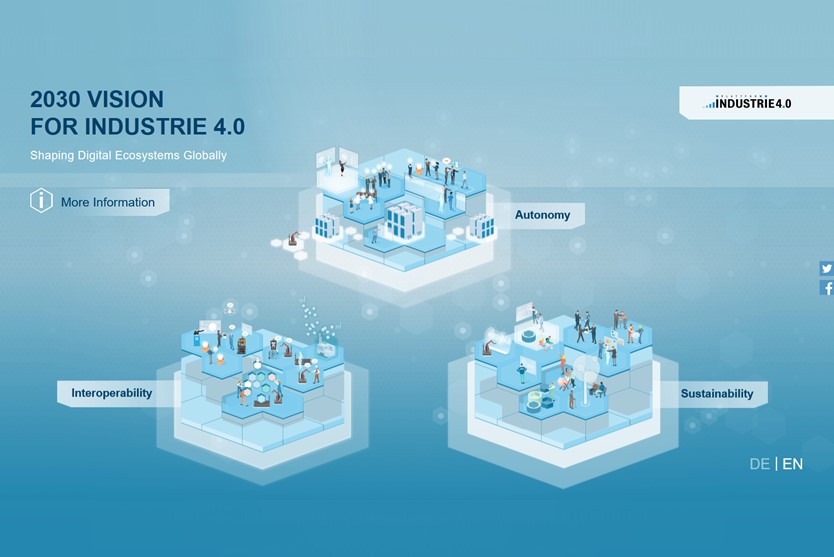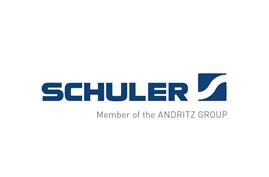
Advancing digitalization at Schuler: Stephan Paul, Dieter Reisch, Tobias Schwarz und Jürgen Woll (f.l.t.r.)
© Schuler
What were the challenges to be solved and what specific benefits were achieved?
It was two years ago that Schuler set about implementing a digital strategy. The ultimate goal was to deploy an intelligent networked press shop featuring smart integration of big data and the Industrial Internet of Things, in order to make our customers’ manufacturing operations as stable and productive as possible. Significant progress towards this goal has already been made.
Currently, we’re modernizing the process and control levels of our presses, and by doing so, are laying the groundwork for additional digital services that we’ll be offering starting in the fall of 2018. We are consolidating the press control system into standardized basic modules and product-specific modules, each of which will have standardized guidelines for programming, software interfaces, hardware and for visualizing the operator panels, for example. These modules will then serve as a basis for product development in all Schuler divisions. Depending on the specific customer and the requirements involved, they can be individually expanded to include machine-specific functions for analysis, diagnostics, maintenance, and simulation.
How can the Industrie 4.0 approach be described?
This gives customers access to a host of digitally supported analytics and optimization tools to assess and increase the efficiency of their overall system by using targeted data analyses and working closely with Schuler experts. These tools are built on data collected throughout the process chain and acquired by sensors within the system. This data provides information about energy consumption, load cycles, downtime, setup time, performance and quality status (along with any decreases), and potential operator errors, for example.
“Unused press potential can be utilized effectively, and production errors or irregularities can be predicted well in advance thanks to proactive maintenance.” Tobias Schwarz, Head of Central Product Development at Schuler
What could be achieved?
Integrated internet functions and apps that can be used on stationary operating units or smart devices are just as important as standard interfaces for customer ERP and SAP systems. The top priorities in this area also include Cyber Security, and Schuler will address this need with additional dedicated resources developed specifically for automation technology.
At the heart of Schuler’s digital toolkit is the Machine Monitoring System, which features six different function modules. These modules can be used to collect, analyze, store, and evaluate production conditions. The system is compatible with both new and existing machinery, and can be operated and controlled by customers directly on their plant equipment, via their servers, or over their network¬ – and in the future also from the cloud.
What measures have been taken to achieve the solution?
1. OEE MONITORING
The OEE (Overall Equipment Effectiveness) is an extremely important system-related metric. It provides information about the changes from actual to target values in the areas of availability, performance and quality. The OEE is equal to 100% when the system produces nothing but acceptable parts at the full programmed stroke rate over the entire time of production. Any disruptions or errors will lower the number of acceptable parts produced, and by extension, the OEE.
2. PROCESS MONITORING
The raw data collected here is essentially the same as the data used for condition monitoring, but with one difference: Collection takes place during the actual production process instead of in a test run. Are the quality and quantity of the acceptable parts exactly what was expected? Are the press force and vibration progression in order? Which parameters may need to be adjusted so that they are exactly in sync with the cycle?
3. TRACK & TRACE
Collection, assignment and archiving of every piece of quality-related data for a produced part. This also makes it possible to clearly and reliably identify parts within multi-stage production processes involving increasingly complex assemblies. This gapless documentation is incredibly valuable in the event of any quality problems.
4. CONDITION MONITORING
Machine components are monitored for changes, wear and damage in order to optimize the maintenance process. For this purpose, regular test runs of the system are performed in which vibration data, torque progressions and energy consumption, for example, are measured, stored and compared.
5. POWER MONITORING
In this module, all relevant power supply and energy quality data for the system are stored and analyzed. What does consumption look like as a function of specific operating states? When does the optimal state occur? How efficient is the current consumption? When are there voltage fluctuations or dips?
6. SMART DIAGNOSTICS
Works like the black box in an airplane: Specific data produced during production are automatically stored on a continuous basis. In the event of a malfunction or failure, a retrospective analysis can be performed to determine the cause, for example, a software error or defective component.
What can others learn from it?
With the Industrial Internet of Things, we are trying to create added value for our customers. In concrete terms, it means that we’re equipping our presses with a machine monitoring system, for example, which creates transparency throughout the production process with the aid of extensive data collection. This then enables detailed evaluations for the purpose of improving system availability and efficiency. In the future, this will also make it possible to reliably predict which components need to be repaired or replaced when, before any production irregularities occur.
The digitalization also affecs internal processes at Schuler. We use the latest software and hardware to create more transparency and improve efficiency in all of our departments, divisions and regions. This has allowed us to significantly improve the way we track our international projects, for example, with faster project reporting and a higher quality of data. Aside from this, Schuler fully digitizes its annual strategic planning process on a central IT platform. This platform supports individual process steps, collects all the relevant data, and makes this data available to all of the involved parties within the company.




